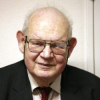Benoit Mandelbrot

Benoit Mandelbrot
Benoit B. Mandelbrot was a Polish-born, French and American mathematician with broad interests in the practical sciences, especially regarding what he labeled as "the art of roughness" of physical phenomena and "the uncontrolled element in life." He referred to himself as a "fractalist". He is recognized for his contribution to the field of fractal geometry, which included coining the word "fractal'", as well as developing a theory of "roughness and self-similarity" in nature...
NationalityFrench
ProfessionMathematician
Date of Birth20 November 1924
CountryFrance
Regular geometry, the geometry of Euclid, is concerned with shapes which are smooth, except perhaps for corners and lines, special lines which are singularities, but some shapes in nature are so complicated that they are equally complicated at the big scale and come closer and closer and they don't become any less complicated.
Everything is roughness, except for the circles. How many circles are there in nature? Very, very few. The straight lines. Very shapes are very, very smooth. But geometry had laid them aside because they were too complicated.
The straight line has a property of self-similarity. Each piece of the straight line is the same as the whole line when used to a big or small extent.
If you look at a shape like a straight line, what's remarkable is that if you look at a straight line from close by, from far away, it is the same; it is a straight line.
One of my conjectures was solved in six months, a second in five years, a third in 10. But the basic conjecture remains-the Mandelbrot Set.
Until a few years ago, the topics in my Ph.D. were unfashionable, but they are very popular today.
The techniques I developed for studying turbulence, like weather, also apply to the stock market
When the weather changes, nobody believes the laws of physics have changed. Similarly, I don't believe that when the stock market goes into terrible gyrations its rules have changed
I didn't want to become a pure mathematician, as a matter of fact, my uncle was one, so I knew what the pure mathematician was and I did not want to be a pure - I wanted to do something different.
The Mandelbrot set is the most complex mathematical object known to mankind.
If you have a hammer, use it everywhere you can, but I do not claim that everything is fractal.
I conceived, developed and applied in many areas a new geometry of nature, which finds order in chaotic shapes and processes. It grew without a name until 1975, when I coined a new word to denote it, fractal geometry, from the Latin word for irregular and broken up, fractus. Today you might say that, until fractal geometry became organized, my life had followed a fractal orbit.
In fact, I barely missed being number one in France in both schools. In particular I did very well in mathematical problems.
I don't seek power and do not run around